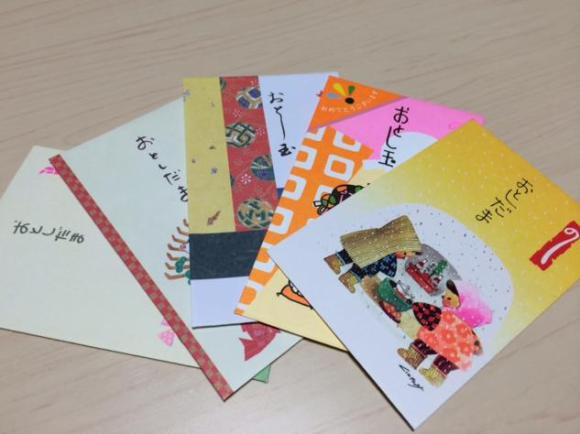
A lot of Japanese people complain about the tipping culture in the US and Canada. Although parting with more money than necessary is a big part of the complaint, a lot of people in Japan dislike the mental anguish of figuring out how much is appropriate.
However, the New Year’s traditional cash presents of otoshidama, while great for kids, are just as riddled with anxiety for adults. Rather than the ambiguous sentimental value of presents, an envelope filled with cash is instantly quantifiable and wide open to judgment.
To avoid looking like a cheapskate or breaking your own bank account, our reporter surveyed those around her to figure out what the going rates for otoshidama are these days.
When it comes to otoshidama money the basic rule of thumb is to adjust the value based on your relationship with the child as well as how well you know the parents. But to get a better idea with regards to a yen-amount here’s what some respondents of our mini-survey had to say.
“Isn’t it something like 500 yen [US$5] times the age? Then again, I don’t know much about when to give. For example, up to three years old you don’t give money?”
(34 year-old mother of one)“If they’re in elementary school, I think… Around two to three thousand yen [$19 – $28]. If they’re in junior high school then 5,000 yen [$48].”
(28 year-old single man)“Only because he’ll fight with brothers, I also gave 3,000 yen [$28] to an elementary school-aged kid.”
(28 year-old single woman)“I guess there’s a difference between the child of a friend and the child of a relative. For a child I meet often, I give one or two thousand yen [$10 – $19] extra.”
(33 year-old married woman)“For grandchildren that I haven’t seen in a while [university students] I give 30,000 yen [$287], but a little more up to 50,000 yen [$479] in some cases.”
(72 year-old grandfather of three)
*NOTE: In Japan 4 is an unlucky number, thus 50,000 yen is the next round amount and “a little more”*“Until they’re in kindergarten 500 to 1,000 yen [$5 – $10]. A lot of people give a toy or candy instead.”
(38 year-old married man)“I think if they’re in elementary or high school 5,000 yen [$48]. Middle school 10,000 yen [$96]. But I only do that with my niece because she’s very cute. I don’t give as much to other kids. Maybe 3,000 yen [$28].”
(35 year-old single woman)
As you can see everyone has their own little system for handing out the cash, but if we average out all the responses, here’s what we get as a general rule.
■ Babies and Pre-Schoolers: 1,000 yen ($10) or a present
■ Elementary School Student: 3,000 – 5,000 yen ($28 – $48)
■ Junior High Student: 5,000 – 10,000 yen ($48 – $96)
*Additional cash will be given on the grounds of extra cuteness or strong relationship. Grandchildren will also receive higher than usual amounts.
There were also a few people who responded: “It depends on my cash flow at the moment,” meaning if they happen to be having a good month then everyone gets a little extra, but if times are tight so are the otoshidama. It may be controversial but adds a little suspense to the occasion and could even help teach kids the value of a yen.
So now you know the rules, and not a moment too… Oh.
Well, you can always bookmark this info for next year. Also, if you’re having a particularly hard year financially, now you know to just try and spend as little time around children as possible. That should reduce your burden come December.
Or, if you happened to have gotten an otoshidama this year, you can know exactly how much you mean to that person. And that, my friends, is why I’ll never speak to my sister-in-law again.
Original Article by Anji Tabata
[ Read in Japanese ]

 At what age should parents stop giving kids New Year’s otoshidama money? Japanese netizens answer
At what age should parents stop giving kids New Year’s otoshidama money? Japanese netizens answer Flush with New Year’s present cash, Japanese kids can now look forward to…saving it
Flush with New Year’s present cash, Japanese kids can now look forward to…saving it 85-year-old great-grandmother from Hiroshima is Japan’s newest virtual YouTuber/idol【Video】
85-year-old great-grandmother from Hiroshima is Japan’s newest virtual YouTuber/idol【Video】 Three misconceptions guys have about how to be popular with the ladies
Three misconceptions guys have about how to be popular with the ladies Difference between a student at a normal high school and a technical high school
Difference between a student at a normal high school and a technical high school How to order snacks on a Shinkansen bullet train in Japan
How to order snacks on a Shinkansen bullet train in Japan Burger King Japan suddenly adds Dr. Pepper and Dr. Pepper floats to its menu nationwide
Burger King Japan suddenly adds Dr. Pepper and Dr. Pepper floats to its menu nationwide New Nintendo Lego kit is a beautiful piece of moving pixel art of Mario and Yoshi【Photos】
New Nintendo Lego kit is a beautiful piece of moving pixel art of Mario and Yoshi【Photos】 Hello, cosmetics! Clinique teams up with Hello Kitty this summer for first-time collaboration
Hello, cosmetics! Clinique teams up with Hello Kitty this summer for first-time collaboration Demon Slayer: Kimetsu no Yaiba gets new roller coaster attractions and food at Universal Studios Japan
Demon Slayer: Kimetsu no Yaiba gets new roller coaster attractions and food at Universal Studios Japan 11 different ways to say “father” in Japanese
11 different ways to say “father” in Japanese Kyoto tea merchant’s matcha parfait ice cream bars: The desserts we’ve been waiting 187 years for
Kyoto tea merchant’s matcha parfait ice cream bars: The desserts we’ve been waiting 187 years for East meets West in the Pacific-centered version of the world map
East meets West in the Pacific-centered version of the world map What do you eat when you catch a cold? We asked 11 of our Japanese reporters
What do you eat when you catch a cold? We asked 11 of our Japanese reporters Shinjuku izakaya’s all-you-can-eat-and-drink plan is one of Tokyo’s best secret cheap eats
Shinjuku izakaya’s all-you-can-eat-and-drink plan is one of Tokyo’s best secret cheap eats Nintendo history you can feel – Super NES, N64, and GameCube controllers become capsule toys
Nintendo history you can feel – Super NES, N64, and GameCube controllers become capsule toys “The most Delicious Cup Noodle in history” – Japan’s French Cup Noodle wins our heart【Taste test】
“The most Delicious Cup Noodle in history” – Japan’s French Cup Noodle wins our heart【Taste test】 Starbucks releases a cute Frappuccino and Unicorn Cake…but not in Japan
Starbucks releases a cute Frappuccino and Unicorn Cake…but not in Japan Kyoto Tower mascot termination reveals dark side behind cute Japanese characters
Kyoto Tower mascot termination reveals dark side behind cute Japanese characters McDonald’s Japan’s Soft Twist Tower: A phantom ice cream only sold at select branches
McDonald’s Japan’s Soft Twist Tower: A phantom ice cream only sold at select branches Yabai Ramen: What makes this Japanese ramen so dangerous?
Yabai Ramen: What makes this Japanese ramen so dangerous? Finally! Nintendo Japan expands Switch 8-bit controller sales to everybody, Online member or not
Finally! Nintendo Japan expands Switch 8-bit controller sales to everybody, Online member or not Japanese government wants to build luxury resorts in all national parks for foreign tourists
Japanese government wants to build luxury resorts in all national parks for foreign tourists To combat declining birth rate, Japan to begin offering “Breeding Visas” to foreigners
To combat declining birth rate, Japan to begin offering “Breeding Visas” to foreigners 10 things you should buy at 7-Eleven in Japan
10 things you should buy at 7-Eleven in Japan Studio Ghibli releases anime heroine cosplay dresses that are super comfy to wear
Studio Ghibli releases anime heroine cosplay dresses that are super comfy to wear Woman charged for driving suitcase without a license in Osaka
Woman charged for driving suitcase without a license in Osaka Studio Ghibli unveils My Neighbour Totoro miniature house model
Studio Ghibli unveils My Neighbour Totoro miniature house model Kyoto experiencing problems with foreign tourists not paying for bus fares, but not on purpose
Kyoto experiencing problems with foreign tourists not paying for bus fares, but not on purpose Fighting mild hunger with a Japanese soda that turns into jelly in the stomach【Taste test】
Fighting mild hunger with a Japanese soda that turns into jelly in the stomach【Taste test】 Studio Ghibli’s Howl’s Moving Castle tapestry unveiled in Japan for first time
Studio Ghibli’s Howl’s Moving Castle tapestry unveiled in Japan for first time McDonald’s new Happy Meals offer up cute and practical Sanrio lifestyle goods
McDonald’s new Happy Meals offer up cute and practical Sanrio lifestyle goods Sales of Japan’s most convenient train ticket/shopping payment cards suspended indefinitely
Sales of Japan’s most convenient train ticket/shopping payment cards suspended indefinitely Sold-out Studio Ghibli desktop humidifiers are back so Totoro can help you through the dry season
Sold-out Studio Ghibli desktop humidifiers are back so Totoro can help you through the dry season Japanese government to make first change to romanization spelling rules since the 1950s
Japanese government to make first change to romanization spelling rules since the 1950s Foreigner’s request for help in Tokyo makes us sad for the state of society
Foreigner’s request for help in Tokyo makes us sad for the state of society Ghibli founders Toshio Suzuki and Hayao Miyazaki contribute to Japanese whisky Totoro label design
Ghibli founders Toshio Suzuki and Hayao Miyazaki contribute to Japanese whisky Totoro label design Doraemon found buried at sea as scene from 1993 anime becomes real life【Photos】
Doraemon found buried at sea as scene from 1993 anime becomes real life【Photos】 Tokyo’s most famous Starbucks is closed
Tokyo’s most famous Starbucks is closed Princesses, fruits, and blacksmiths: Study reveals the 30 most unusual family names in Japan
Princesses, fruits, and blacksmiths: Study reveals the 30 most unusual family names in Japan Japanese model home provides model wife and model daughter so you can feel the joy of family life
Japanese model home provides model wife and model daughter so you can feel the joy of family life Barely half of Japanese men in survey will give thank-you gift to women for Valentine’s chocolate
Barely half of Japanese men in survey will give thank-you gift to women for Valentine’s chocolate “Hate summer homework, kids? We’ll do it for you!” A disturbingly booming business in Japan
“Hate summer homework, kids? We’ll do it for you!” A disturbingly booming business in Japan Gear up for Valentine’s Day with this lipstick…chocolate!
Gear up for Valentine’s Day with this lipstick…chocolate! Online survey reveals the types of guys elementary school girls DON’T want to date
Online survey reveals the types of guys elementary school girls DON’T want to date 9 middle-aged Japanese men come to work in the clothes they’d like their partners to wear
9 middle-aged Japanese men come to work in the clothes they’d like their partners to wear We purchase a Starbucks Lucky Bag, makes us look at the big picture
We purchase a Starbucks Lucky Bag, makes us look at the big picture Tohoku tsunami survivor’s $12K camera: heart-felt gift or PR stunt?
Tohoku tsunami survivor’s $12K camera: heart-felt gift or PR stunt? Sanrio mascots promote pacifism on 70th anniversary of Japan’s surrender
Sanrio mascots promote pacifism on 70th anniversary of Japan’s surrender Seven unbelievable jobs that actually exist in Japan
Seven unbelievable jobs that actually exist in Japan New traditional rice topping selling well, but at 10,000 yen a pop it doesn’t take much
New traditional rice topping selling well, but at 10,000 yen a pop it doesn’t take much Japanese teacher criticized for attending son’s entrance ceremony instead of her own school’s
Japanese teacher criticized for attending son’s entrance ceremony instead of her own school’s The Bank of Japan is really jazzed up about the new 10,000 yen bill
The Bank of Japan is really jazzed up about the new 10,000 yen bill All insolvent idol group “The Margarines” to debut, total debt of all members: 127 million yen
All insolvent idol group “The Margarines” to debut, total debt of all members: 127 million yen Japanese elementary school “randoseru” bag brand creates Showa-inspired line for adults
Japanese elementary school “randoseru” bag brand creates Showa-inspired line for adults
Leave a Reply